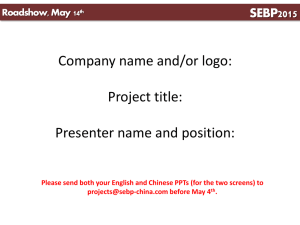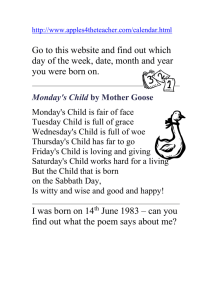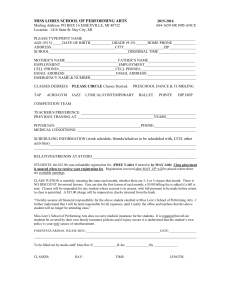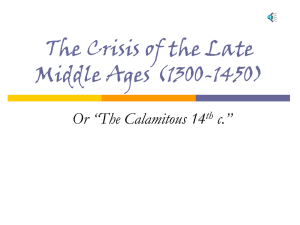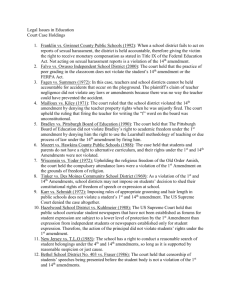14.Fi.HS.3&4solution
advertisement
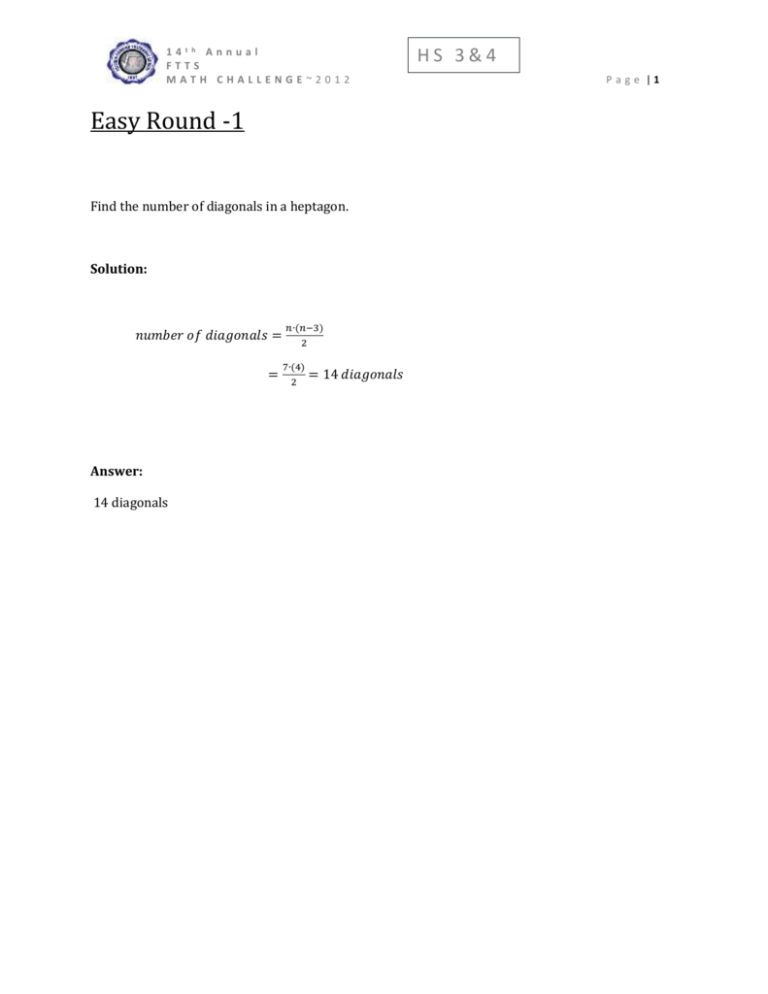
14th Annual
FTTS
MATH CHALLENGE~2012
Easy Round -1
Find the number of diagonals in a heptagon.
Solution:
𝑛𝑢𝑚𝑏𝑒𝑟 𝑜𝑓 𝑑𝑖𝑎𝑔𝑜𝑛𝑎𝑙𝑠 =
=
Answer:
14 diagonals
𝑛∙(𝑛−3)
2
7∙(4)
2
= 14 𝑑𝑖𝑎𝑔𝑜𝑛𝑎𝑙𝑠
HS 3&4
P a g e |1
HS 3&4
14th Annual
FTTS
MATH CHALLENGE~2012
P a g e |2
Easy Round -2
In a triangle ABC, the measurement of angle A is 30°, measurement of angle B is 135° and side 𝑏 =
4√2cm. Find the value of side 𝑎.
Solution:
Using the Law of Sine,
𝑎
sin 𝐴
𝑎
sin 30°
𝑎
1
2
4√2𝑐𝑚
= sin 135°
=
𝑎=
Answer:
4cm
𝑏
= sin 𝐵
4√2𝑐𝑚
√2
2
4√2𝑐𝑚∙
√2
2
1
2
= 4𝑐𝑚
HS 3&4
14th Annual
FTTS
MATH CHALLENGE~2012
P a g e |3
Easy Round -3
Calculate cot 300 °.
Solution:
cot 300° =
cos 300°
,
sin 300°
cos 300°
but since 300° is in the 4th quadrant so sin 300° is negative thus we have,
1
2
cot 300° = − sin 300° = − √3
=−
2
Answer:
−
√3
3
1
√3
=−
√3
3
HS 3&4
14th Annual
FTTS
MATH CHALLENGE~2012
P a g e |4
Easy Round -4
Find x in the figure.
A
135˚
x
C
B
Solution:
Using the Law of Cosine, we have 𝑎2 = 𝑏 2 + 𝑐 2 − 2𝑏𝑐 ∙ cos 𝐴
(√10)2 = (√2)2 + 𝑥 2 − 2(√2)𝑥 ∙ cos 135°
10 = 2 + 𝑥 2 − 2√2𝑥 ∙ (−
1
)
√2
10 = 2 + 𝑥 2 + 2𝑥
0 = 𝑥 2 + 2𝑥 − 8
0 = (𝑥 + 4)(𝑥 − 2)
𝑥 = −4
𝑥=2
Since the side of a triangle can never be negative then 𝑥 = 2
Answer:
2
by factoring
14th Annual
FTTS
MATH CHALLENGE~2012
HS 3&4
P a g e |5
Easy Round -5
A rectangular piece of paper ABCD 4cm x 1cm is folded along the line MN such that vertex C
coincides with vertex A, as shown in the picture. What is the area of quadrilateral ANMD’
A
D
B
C
D
A
C
B
D’
M
A
N
B
Solution:
1
A(ANMD) = 2 𝐴(𝐴𝐵𝐶𝐷)
1
A(ANMD) = 2·4·1 = 2𝑐𝑚2
Answer :
2 cm2
D
C
HS 3&4
14th Annual
FTTS
MATH CHALLENGE~2012
P a g e |6
Average Round – 1
The measure of an interior angle in a regular polygon is 108°. How many sides does the polygon
have?
Solution:
𝑖𝑛𝑡𝑒𝑟𝑖𝑜𝑟 𝑎𝑛𝑔𝑙𝑒 𝑜𝑓 𝑎 𝑟𝑒𝑔𝑢𝑙𝑎𝑟 𝑝𝑜𝑙𝑦𝑔𝑜𝑛 =
(𝑛−2)∙180°
𝑛
108° =
(𝑛−2)∙180°
𝑛
108°𝑛 = (𝑛 − 2) ∙ 180°
108°𝑛 = 180°𝑛 − 360°
360° = 180°𝑛 − 108°𝑛
360° = 72°𝑛
5=𝑛
Answer:
5 sides
14th Annual
FTTS
MATH CHALLENGE~2012
HS 3&4
P a g e |7
Average Round – 2
A cylinder has a radius equal to its height. The total surface area of the cylinder is 100𝜋𝑐𝑚2 . Find its
volume.
Solution:
𝑡𝑜𝑡𝑎𝑙 𝑠𝑢𝑟𝑓𝑎𝑐𝑒 𝑎𝑟𝑒𝑎 = 2𝜋𝑟 2 + 2𝜋ℎ ∙ 𝑟
100𝜋𝑐𝑚2 = 2𝜋𝑟 2 + 2𝜋𝑟 ∙ 𝑟 since ℎ = 𝑟
100𝜋𝑐𝑚2 = 4𝜋𝑟 2
5𝑐𝑚 = 𝑟 = ℎ
𝑉𝑜𝑙𝑢𝑚𝑒 𝑜𝑓 𝑐𝑦𝑙𝑖𝑛𝑑𝑒𝑟 = 𝜋𝑟 2 ∙ ℎ
𝑉 = 𝜋 ∙ 5𝑐𝑚2 ∙ 5𝑐𝑚
𝑉 = 125𝑐𝑚3
𝑉 = (125 ∙ 3.14)𝑐𝑚3 ≈ 392.5𝑐𝑚3
Answer:
125𝜋𝑐𝑚3 ≈ 392.5𝑐𝑚3
14th Annual
FTTS
MATH CHALLENGE~2012
HS 3&4
P a g e |8
Average Round – 3
A three-digit number is formed by choosing elements from the set {0, 1, 3, 4, 5, 7, 8, 9}. How many
numbers are divisible by four (4) without repetition?
Solution:
A number is divisible by four (4) if the last two digits is divisible by four. This is sequence of
three-digits divisible by four are 𝑛04, 𝑛08, 𝑛12, 𝑛16, 𝑛20, 𝑛24, 𝑛28, 𝑛32, 𝑛36, 𝑛40, ….The sequence of
last digit is 4, 8, and 0 since there is no 2 and 6 in the given sequence
If the last digit is four (4), we have
⏟
6
∙⏟
1∙⏟
1=6
{1,3,5,7,8,9}
0
4
⏟
5
{1,3,5,7,9}
∙⏟
1∙⏟
1=5
8
4
If the last digit is eight (8), we have
⏟
6
∙⏟
1∙⏟
1=6
{1,3,4,5,7,9}
0
8
⏟
5
{1,3,5,7,9}
∙⏟
1∙⏟
1=5
4
If the last digit is zero (0), we have
6∙ ⏟
2 ∙⏟
1 = 12
{4,8}
0
Adding all the results, we have 6 + 5 + 6 + 5 + 12 = 34
Answer:
34 ways
8
14th Annual
FTTS
MATH CHALLENGE~2012
HS 3&4
Average Round – 4
How many integer solution does the inequality x3 < 64 < x2 have ?
Solution:
By solving the inequality separately
𝑥 3 <64
64<𝑥 2
𝑥 3 -64<0
64-𝑥 2 <0
(x-4)(𝑥 2 +4x+16)<0
(8-x)(8+x)<0
x<4
-8<x<8
Since the discriminant of 𝑥 2 +4x+16 is less than 0, it does not have real solution. We get
x<4 and -8<x<8. By combining the two inequalities, we will have -8<x<4.
Therefore, the integers from -7 to 3 are solutions. There are 11 integers.
Answer :
11
P a g e |9
14th Annual
FTTS
MATH CHALLENGE~2012
HS 3&4
P a g e | 10
Average Round – 5
The square ABCE has side length 4 cm and the same area as the triangle ECD. What is the distance
from the point D to the line g?
4
4
Solution:
1
∙ 𝐸𝐶 ∙ ℎ
{
2
𝐴(𝐴𝐵𝐶𝐸) = 4 · 4 = 16
𝐴(𝐸𝐶𝐷) =
1
∙4∙ℎ =4∙4
2
h = 8cm
The distance from D to the line g is 8cm+4cm = 12cm
Answer:
12
14th Annual
FTTS
MATH CHALLENGE~2012
HS 3&4
P a g e | 11
Difficult Round – 1
𝑎∙𝑏 =6
Given { 𝑏 ∙ 𝑐 = 15 where 𝑎, 𝑏 𝑎𝑛𝑑 𝑐 ∈ Ζ+ . Find the value of a, b, and c.
𝑎 ∙ 𝑐 = 10
Solution:
Multiplying the given equations, we have
𝑎 ∙ 𝑏 ∙ 𝑏 ∙ 𝑐 ∙ 𝑎 ∙ 𝑐 = 6 ∙ 15 ∙ 10
𝑎2 ∙ 𝑏 2 ∙ 𝑐 2 = 3 ∙ 2 ∙ 3 ∙ 5 ∙ 2 ∙ 5
𝑎2 ∙ 𝑏 2 ∙ 𝑐 2 = 22 ∙ 32 ∙ 52 we will just take the positive since 𝑎, 𝑏 𝑎𝑛𝑑 𝑐 ∈ Ζ+
𝑎∙𝑏∙𝑐 =2∙3∙5
𝑎=
𝑎𝑏𝑐
𝑏𝑐
=
2∙3∙5
3∙5
=2
𝑏=
𝑎𝑏𝑐
𝑎𝑐
=
2∙3∙5
2∙5
=3
𝑐=
𝑎𝑏𝑐
𝑎𝑏
=
2∙3∙5
2∙3
=5
Answer:
𝑎 = 2, 𝑏 = 3, 𝑎𝑛𝑑 𝑐 = 5
HS 3&4
14th Annual
FTTS
MATH CHALLENGE~2012
P a g e | 12
Difficult Round – 2
1
Find the constant term in the expansion of (𝑥 + 𝑥 2 )12.
Solution:
1
12
Let (𝑟−1
)(𝑥)12−𝑟+1 (𝑥2 )𝑟−1 be the constant term.
12
(𝑟−1
)
𝑥 12−𝑟+1
𝑥 2𝑟−2
12
12
= (𝑟−1
)𝑥 12−𝑟+1−2𝑟+2 = (𝑟−1
)𝑥 15−3𝑟
If this is the constant term then, the power of 𝑥 must be zero (0). This gives us 15 − 3𝑟 = 0
and 𝑟 = 5.
In other words, the constant term is the fifth term. Substituting 𝑟 = 5 in the expression, we
have
1
1
12
(5−1
)(𝑥)12−5+1 (𝑥2 )5−1 = (12
)(𝑥)8 (𝑥 2 )4 = (12
)
4
4
12!
(12
) = 8!∙4! =
4
Answer:
495
12∙11∙10∙9∙8!
8!∙4∙3∙2
= 495
14th Annual
FTTS
MATH CHALLENGE~2012
HS 3&4
P a g e | 13
Difficult Round – 3
Ma’am Wee picks out two numbers a and b from the set {1, 2, 3, …, 26}. The product ab is equal to
the sum of the remaining 24 numbers. What is the value of |a-b|?
Solution:
𝑎∙𝑏 =
26 ∙ 27
−𝑎−𝑏
2
𝑎𝑏 + 𝑎 + 𝑏 = 351
(𝑎 + 1)(𝑏 + 1) − 1 = 351
(𝑎 + 1)(𝑏 + 1) = 352
We know that a and b must be less than or equal to 26.
The only factors of 352 that satisfies the condition are 22 and 16.
Let’s assume that,
a+1 = 22 and b+1 = 16. So,
a is 21 and b is 15.
The value of|𝑎 − 𝑏| is |21 − 15| = 6
Answer :
6
14th Annual
FTTS
MATH CHALLENGE~2012
HS 3&4
Difficult Round – 4
The last non-zero digit of the number K = 259·34·553 is
Solution:
K = 259 · 553 ∙ 34
= (2 ∙ 5)53 · 26 ∙ 34
= 1053 ∙ 64 ∙ 81
= 5184·1053
Therefore, the first non-zero digit from unit digit of K is 4.
Answer:
4
P a g e | 14
14th Annual
FTTS
MATH CHALLENGE~2012
HS 3&4
P a g e | 15
Difficult Round – 5
`
Two sides of a quadrilateral are equal to 1 and 4. One of the diagonals, which is 2 in length, divides
it into two isosceles triangles. Then the perimeter of the quadrilateral is equal to:
Solution :
A
4
D
1
2
B
y
x
C
Let ABCD be a quadrilateral.
In ΔABC, by triangle inequality, we have
2–1<x<2+1
1<x<3
The length of x must be 2.
In ΔACD, 4 – 2 < y < 4 + 2
2 < y <6.
The length of y must be 4. So, the perimeter of the quadrilateral ABCD is 4 + 4 + 1 + 2 = 11.
Answer:
11
14th Annual
FTTS
MATH CHALLENGE~2012
HS 3&4
P a g e | 16
Tie Breaker – 1
The altitude to the hypotenuse of a right triangle separates the hypotenuse into two segments of
9m and 3m. Find the length of the altitude.
Solution:
Using the Euclidean Theorem, we have 𝑎𝑙𝑡𝑖𝑡𝑢𝑑𝑒 2 = 9𝑚 ∙ 3𝑚
𝑎𝑙𝑡 2 = 27𝑚2
𝑎𝑙𝑡𝑖𝑡𝑢𝑑𝑒 = 3√3𝑚
Answer:
3√3
14th Annual
FTTS
MATH CHALLENGE~2012
HS 3&4
P a g e | 17
Tie Breaker – 2
The sum of the digits of a nine-digit number is 8. What is the product of these digits?
Solution:
The number must have 0 as its digit(s). Thus, the product of the digit of this number will be zero.
Answer:
0
14th Annual
FTTS
MATH CHALLENGE~2012
HS 3&4
Tie Breaker – 3
M and N are the midpoints of the equal sides of an isosceles triangle.
The area of the missing (?) quadrilateral piece is:
Solution:
Since M and N are the midpoint, the triangle is divided into two equal parts.
3+?=3+6
3+?=9
? =6
Answer :
6
P a g e | 18
14th Annual
FTTS
MATH CHALLENGE~2012
HS 3&4
P a g e | 19
Tie Breaker – 4
The numbers 144 and 220 when divided by the positive integer number x both give a remainder of
11. Find x.
Solution:
144 = 𝑎𝑥 + 11
{
220 = 𝑏𝑥 + 11
ax = 133 = 19·7
bx = 209 = 19·11
The value of x must me 19.
Answer :
19
14th Annual
FTTS
MATH CHALLENGE~2012
HS 3&4
Tie Breaker - 5
The maximum natural value n, for which n200<5300 is equal to
Solution:
𝑛200 < 5300
𝑛2·100 < 53∙100
𝑛 2 < 53
𝑛2 < 125
The maximum natural number n must be 11.
Answer :
11
P a g e | 20
HS 3&4
14th Annual
FTTS
MATH CHALLENGE~2012
P a g e | 21
Solution:
DoD – 1
Find the area of the figure.
2 cm
2 cm
2 cm
2 cm
2 cm
2 cm
2 cm
2 cm
2 cm
Solution:
2 cm
A1
2 cm
2 cm
2 cm
A2
2 cm
A3
A4
𝐴1 + 𝐴2 + 𝐴3 + 𝐴4 = 𝑎𝑟𝑒𝑎 𝑜𝑓 𝑡ℎ𝑒 𝑓𝑖𝑔𝑢𝑟𝑒
2 cm
𝐴1 = 2𝑐𝑚 ∙ 2𝑐𝑚 = 4𝑐𝑚2
𝐴2 = 2𝑐𝑚 ∙ 2𝑐𝑚 = 4𝑐𝑚2
2 cm
𝐴3 = 10𝑐𝑚 ∙ 2𝑐𝑚 = 20𝑐𝑚2
𝐴4 = 4𝑐𝑚 ∙ 2𝑐𝑚 = 8𝑐𝑚2
𝑎𝑟𝑒𝑎 𝑜𝑓 𝑡ℎ𝑒 𝑓𝑖𝑔𝑢𝑟𝑒 = 4𝑐𝑚2 + 4𝑐𝑚2 + 20𝑐𝑚2 + 8𝑐𝑚2
𝑎𝑟𝑒𝑎 𝑜𝑓 𝑡ℎ𝑒 𝑓𝑖𝑔𝑢𝑟𝑒 = 36𝑐𝑚2
Answer:
36𝑐𝑚2
14th Annual
FTTS
MATH CHALLENGE~2012
HS 3&4
P a g e | 22
DoD - 2
What is the unit digit of 20122012 ?
Solution:
2012 ≡ 2(𝑚𝑜𝑑 10)
20122 ≡ 4(𝑚𝑜𝑑 10)
20123 ≡ 8(𝑚𝑜𝑑 10)
20124 ≡ 6(𝑚𝑜𝑑 10)
20125 ≡ 2(𝑚𝑜𝑑 10)
20126 ≡ 4(𝑚𝑜𝑑 10)
20127 ≡ 8(𝑚𝑜𝑑 10)
20128 ≡ 6(𝑚𝑜𝑑 10)
⋮
≡ ⋮
(⋮)
We can notice that the unit digit repeats its sequence which 2, 4, 8, and 6 and since 2012 is
divisible by 4 then,
20122012 ≡ 6 (𝑚𝑜𝑑 10)
Answer:
6
14th Annual
FTTS
MATH CHALLENGE~2012
HS 3&4
P a g e | 23

